Related Research Articles

Rio de Janeiro, or simply Rio, is the capital of the state of Rio de Janeiro. It is the second-most-populous city in Brazil and the sixth-most-populous city in the Americas.
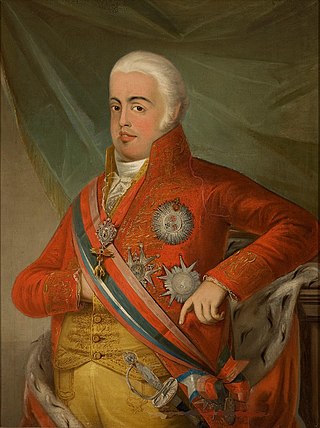
Dom John VI, nicknamed "the Clement", was King of the United Kingdom of Portugal, Brazil and the Algarves from 1816 to 1825. Although the United Kingdom of Portugal ceased to exist de facto beginning in 1822, he remained its monarch de jure between 1822 and 1825. After the recognition of the independence of Brazil under the Treaty of Rio de Janeiro of 1825, he continued as King of Portugal until his death in 1826. Under the same treaty, he also became titular Emperor of Brazil for life, while his son, Emperor Pedro I, was both de facto and de jure the monarch of the newly independent country.

The music of Brazil encompasses various regional musical styles influenced by European, American, African and Amerindian forms. Brazilian music developed some unique and original styles such as forró, repente, coco de roda, axé, sertanejo, samba, bossa nova, MPB, gaucho music, pagode, tropicália, choro, maracatu, embolada, frevo, brega, modinha and Brazilian versions of foreign musical styles, such as rock, pop music, soul, hip-hop, disco music, country music, ambient, industrial and psychedelic music, rap, classical music, fado, and gospel.
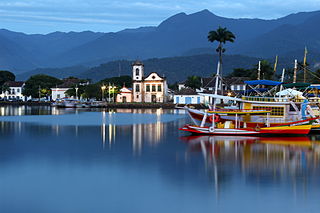
Paraty is a preserved Portuguese colonial (1500–1822) and Brazilian Imperial (1822–1889) municipality with a population of about 43,000. The name "Paraty" originates from the local Guaianá Indians' indigenous Tupi language, named for an abundant local fish native to the region. Paraty is located on the Costa Verde, a lush green corridor that runs along the coastline of the state of Rio de Janeiro, in Brazil. Paraty has become a tourist destination, known for its historic town center and the coast and mountains in the region. The historic center of the city, as well as four areas of the Atlantic Forest, were inscribed on the UNESCO World Heritage List in 2019 under the title "Paraty and Ilha Grande".

Dona Maria Leopoldina of Austria was the first Empress of Brazil as the wife of Emperor Dom Pedro I from 12 October 1822 until her death. She was also Queen of Portugal during her husband's brief reign as King Dom Pedro IV from 10 March to 2 May 1826.
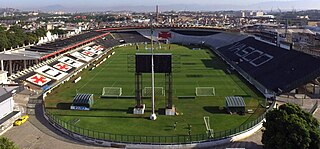
Estádio Vasco da Gama, also known as São Januário, owing to its location on a street of the same name, is the home ground of Club de Regatas Vasco da Gama. Its facade is listed by the National Historical and Artistic Heritage.

The Military Academy of Agulhas Negras is the biggest among several schools of formation of combatant officers of the Brazilian Army. It originated in 1792 with the creation of the Royal Academy of Artillery, Fortification and Drawing, the first military school of the Americas, in the city of Rio de Janeiro. Today the Academy is located in the city of Resende, in the state of Rio de Janeiro.
Being one of the most ancient nation-states in Europe, Portugal has a long music history, which accompanied and strongly contributed to the development of the music history in Europe.

José Maurício Nunes Garcia was a Brazilian classical composer, one of the greatest exponents of Classicism in the Americas.
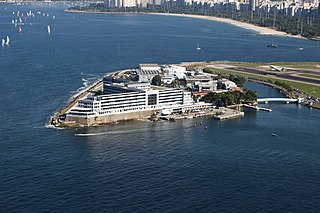
The Naval School is a higher education military academy which aims to train officers for the Brazilian Navy. It is located in Rio de Janeiro, on Villegagnon Island just inside of Guanabara Bay.

The United Kingdom of Portugal, Brazil and the Algarves was a pluricontinental monarchy formed by the elevation of the Portuguese colony named State of Brazil to the status of a kingdom and by the simultaneous union of that Kingdom of Brazil with the Kingdom of Portugal and the Kingdom of the Algarves, constituting a single state consisting of three kingdoms.
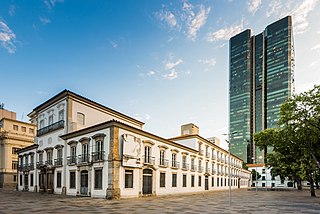
The Paço Imperial, or Imperial Palace, previously known as the Royal Palace of Rio de Janeiro and Palace of the Viceroys, is a historic building in the center of the city of Rio de Janeiro, Brazil. The Paço Imperial was built in the 18th century to serve as a residence for the governors of colonial Brazil. From 1808, it was used as a royal residence by King John VI of Portugal as King of Portugal and later also as King of Brazil. In 1822 it became the city palace of the monarchs of the Empire of Brazil, Pedro I and Pedro II, who used it not as a residence, but as a workplace. It was one of the main political centers of Brazil for nearly 150 years, from 1743 to 1889.
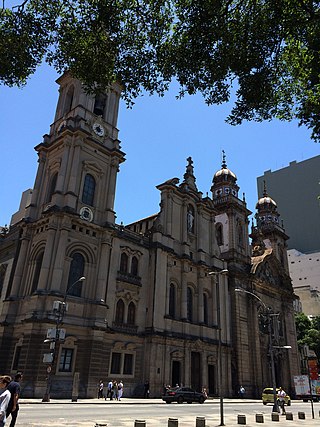
The Old Cathedral of Rio de Janeiro dedicated to Our Lady of Mount Carmel is an old Carmelite church which served as cathedral (Sé) of Rio de Janeiro from around 1808 until 1976. During the 19th century, it was also used successively as Royal and Imperial Chapel by the Portuguese Royal Family and the Brazilian Imperial Family, respectively. It is located in the Praça XV square, in downtown Rio. It is one of the most important historical buildings in the city.
The Portuguese conquest of the Banda Oriental was the armed-conflict that took place between 1816 and 1820 in the Banda Oriental, for control of what today comprises the whole of the Republic of Uruguay, the northern part of the Argentine Mesopotamia and southern Brazil. The four-year armed-conflict resulted in the annexation of the Banda Oriental into the United Kingdom of Portugal, Brazil and the Algarves as the Brazilian province of Cisplatina.

The Portuguese royal court transferred from Lisbon to the Portuguese colony of Brazil in a strategic retreat of queen Maria I of Portugal, prince regent John, the Braganza royal family, its court, and senior officials, totaling nearly 10,000 people, on 27 November 1807. The embarkment took place on the 27th, but due to weather conditions, the ships were only able to depart on 29 November. The Braganza royal family departed for Brazil just days before Napoleonic forces invaded Portugal on 1 December 1807. The Portuguese crown remained in Brazil from 1808 until the Liberal Revolution of 1820 led to the return of John VI of Portugal on 26 April 1821.

The Pantheon of the House of Braganza, also known as the Pantheon of the Braganzas, is the final resting place for many of the members of the House of Braganza, located in the Monastery of São Vicente de Fora in the Alfama district of Lisbon, Portugal. The pantheon's burials have included Portuguese monarchs, Brazilian monarchs, a Romanian monarch, queen consorts of Portugal, and notable Infantes of Portugal, among others.

The Santa Cruz Estate is a former imperial country retreat in Santa Cruz, Rio de Janeiro. Originally a Jesuit estate and convent dating from 1570, it became a residence of the Portuguese viceroys in Brazil at the end of the 18th century. When King John VI and the royal family moved the court to Brazil in 1808, the palace became a royal residence. After the king's return to Portugal, the Prince Regent Pedro I continued to use the palace. Upon his marriage to princess Leopoldina in 1818, they spent their honeymoon in the palace. The estate became one of the imperial palaces with the independence of Brazil in 1822. Emperor Pedro II later used the palace as a summer residence.
Capela may refer to:
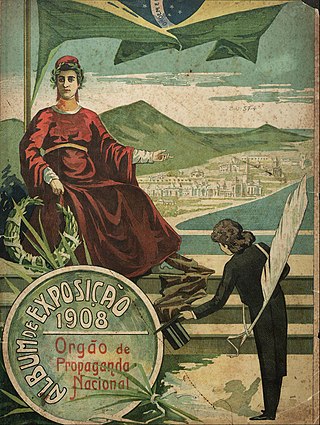
The national commemorative Exhibition of the centenary of the opening of the Ports of Brazil, also known as Brazilian National Exposition of 1908 or the National Exposition of Brazil at Rio de Janeiro, marked a hundred years since the opening of the Brazilian ports acelebrated Brazil's trade and development. It opened in Urca, Rio de Janeiro on 11 August, stayed open for 3 months and received over 1 million visitors.

José da Silva Lisboa, first Baron and Viscount of Cairu, was a Brazilian economist, historian, jurist, publicist and politician, active at the time of the Independence of Brazil and credited for the promotion of important economic reforms. He held various positions in the economic and political administration of Brazil after the transfer or the Portuguese Court in 1808, including Deputy of the Royal Chamber of Commerce and Judge of the House of Supplication.
References
- ↑ Brazil Handbook - Volume 2 - Page 102 A new church was built in 1761, which became the Capela Real with the arrival of the Portuguese royal family in 1808 and subsequently the city's cathedral. .
- ↑ Portuguese Piano Music: An Introduction Nancy Lee Harper - 2013 Page 6 "Joaquim Félix Xavier Bachixa, harpsichordist and pianist who was in service at the Capela Real in Rio de Janeiro during the early part of the 19th century."